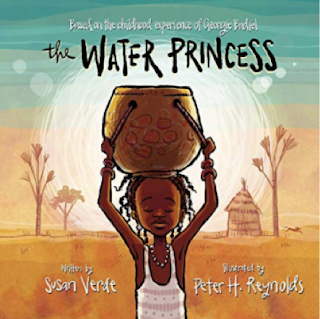A message from the Water Princess
Where to begin? A question I repeatedly asked myself before starting this first blog post. How must I introduce the theme of water and gender in Africa, and shed light on the rather complex issues of water access, sanitation, hygiene, equality, education and community executive structures?
Before delving into the academic studies and published reports, I want to first use this introduction to highlight, in plain terms, the several dimensions of the topic, through analysing segments of a short children's book: The Water Princess, based on the childhood of a now model and activist, Georgie Badiel. This title may invite the imagination of perhaps a glistening mermaid in a sphere of fantasy, however, it works to cleverly allude a contrast with the difficulties in the life of a young female around water and sanitation in her village in Burkina Faso.
What I found fascinating about this book were the powerful messages conveyed in the short sentences that explained the nature and reality of the daily struggles female adults and children face as the ones expected to fetch water far away and yet unclean- two major factors emphasised in the book.
In a more water access and gender affiliated context, The Water Princess forms the basis for beginning to understand how water can become a tool that propels gender inequalities as well as many risks to women and girls. This is since the management of water assigns gender-based roles and responsibilities in households, which can subsequently impact education and health. The emphasised gender-based role of water collecting in UN reports have stated that if the distances travelled to collect water is halved, girls' school attendance, including the Water Princess herself, could increase by 12%. This has also been evident in essentially reducing the substantial gender gaps that have existed in schooling due to the improvement of water proximity, as well as a reduction of adult females' unpaid work. As education for girls can significantly progress, so can their health as they avoid risks of injuries from carrying heavy barrels and a trimmed need to hold either urine or faeces for prolonged water collecting journeys. What is rather more interesting is research studies concluding a direct positive relationship between walk time to water source and diarrhoea infections among children under the age of 5. A Stanford University study published an astonishing piece of data revealing a decrease by 15 minutes of walk time being accompanied by an average 41% reduction in diarrhoea prevalence.
The water problem is also a feminine problem - Saran Kaba Jones, Founder of FACE Africa.
When we look at the long term strategies like the Millennium Development Goals for water, they have targeted massive improvements in the provision of water and sanitation, to help relieve people like the Water Princess from carrying earth-stained water back to the household. However, it still demonstrates a greater need to integrate gender perspectives in order to achieve the goal along with its secondary risks, upon which I aim to dedicate this blog to further explore the 'feminisation of water poverty in Africa', whereby solving the water problem can also empower women. This can be through investigating women involvement in community water projects, understanding problems of hygiene for girls and women, and the more interesting links to women and climate change and its future water projections in Africa.
I hope you enjoy reading this blog!






Love the reference to the children's book! It serves as a good educative piece to highlight the struggles that women and girls face. I'm looking forward to seeing what your blog will entail.
ReplyDeleteThank you so much Sophia!
DeleteWell don Lana!! Such a creative way to introduce the theme of Water and Gender! Can't wait to follow your blog!
ReplyDeleteThank you so much Hamnah!
DeleteThank you Lana for this post! I really enjoy how you engaged with The Water Princess, I think it's very original and gives us a different approach to Water and Development. Reading your blog just reminds us of how impactful access to drinking water can be, especially for children. The link you make with water proximity is very interesting. Is there any way we could improve this aspect and not involve children? Like do any initiatives exist such as schools distributing drinking water? I guess the response to this is not that simple and many other problems would be linked to that.
ReplyDeleteI'm very excited to read more!
Thank you for your comment Maud! I'm very glad this post initiated some self reflection on our privileged childhoods with easy water access as it is indeed a heightened struggle for many children. Your question is very interesting, as focal points of access such as schools would be a major improvement. However, the problems may then lie when schools themselves lack basic drinking water services, with 47% of schools in Sub-Saharan Africa facing limited to no services (UNICEF, 2016). So it really is a complex rounded issue requiring a network of strategies.
DeleteGreat title for your blog and blog post to help you navigate some of the complex (and weighty) issues around water and gender. Your writing style is easy to read and very accessible to a wide audience. Good synthesis of peer reviewed material to back up points brought out in the Water Princess.
ReplyDeleteI would encourage you to post regularly so that we can read more about the Water Women of Africa!
(GEOG0036 PGTA)
Thank you for your feedback Kerry!
Delete